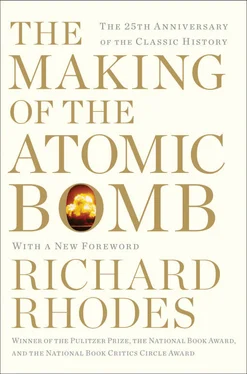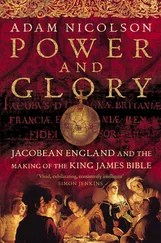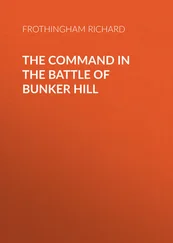“There was no question,” says Hahn, “of any closer relationship between us outside the laboratory. Lise Meitner had had a strict, lady-like upbringing and was very reserved, even shy.” They never ate lunch together, never went for a walk, met only in colloquia and in the wood shop. “And yet we were really close friends.” 298She whistled Brahms and Schumann to him to pass the long hours taking timed readings of radioactivity to establish identifying half-lives, and when Rutherford came through Berlin in 1908 on his way back from the Nobel Prize ceremonies she selflessly accompanied Mary Rutherford shopping while the two men indulged themselves in long talks.
The close friends moved together to the new institute in 1912 and worked to prepare an exhibit for the Kaiser. In his first venture into radiochemistry, in London before he went to Montreal, Hahn had spied out what he took to be a new element, radiothorium, that was one hundred thousand times as radioactive as its modest namesake. At McGill he found a third substance intermediate between the other two; he named it “meso thorium” and it was later identified as an isotope of radium. Mesothorium compounds glow in the dark at a different level of faint illumination from radiothorium compounds. Hahn thought the difference might amuse his sovereign. On a velvet cushion in a little box he mounted an unshielded sample of mesothorium equivalent in radiation intensity to 300 milligrams of radium. He presented his potent offering to the Kaiser and asked him to compare it to “an emanating sample of radiothorium that produced in the dark very nice luminous moving shapes on [a] screen.” 299No one warned His Majesty of the radiation hazard because no safety standards for radiation exposure had yet been set. “If I did the same thing today,” Hahn said fifty years later, “I should find myself in prison.” 300
The mesothorium caused no obvious harm. The Kaiser passed on to the second institute, half a block up Faradayweg northwest beyond the angled wing. Two senior chemists managed the Chemistry Institute where Hahn and Meitner worked, but the Institute for Physical Chemistry and Electrochemistry, to give it its full name, was established specifically for the man who was its first director, a difficult, inventive German-Jewish chemist from Breslau named Fritz Haber. It was a reward of sorts. A German industrial foundation paid for it and endowed it because in 1909 Haber had succeeded in developing a practical method of extracting nitrogen from the air to make ammonia. The ammonia would serve for artificial fertilizer, replacing Germany’s and the world’s principal natural source, sodium nitrate dug from the bone-dry northern desert of Chile, an expensive and insecure supply. More strategically, the Haber process would be invaluable in time of war to produce nitrates for explosives; Germany had no nitrates of its own.
Kaiser Wilhelm enlarged at the dedication on the dangers of firedamp, the explosive mixture of methane and other gases that accumulates in mines. He urged his chemists to find some early means of detection. That was a task, he said, “worthy of the sweat of noble brows.” 301Haber, noble brow—he shaved his bullet head, wore round horn-rimmed glasses and a toothbrush mustache, dressed well, wined and dined in elegance but suffered bitter marital discord—set out to invent a firedamp whistle that would sound a different pitch when dangerous gases were present. With a fine modern laboratory uncontaminated by old radioactivity Hahn and Meitner went to work at radiochemistry and the new field of nuclear physics. The Kaiser returned from Dahlem to his palace in Berlin, happy to have lent his name to yet another organ of burgeoning German power.
* * *
In the summer of 1913 Niels Bohr sailed with his young wife to England. He followed the second and third parts of his epochal paper, which he had sent ahead by mail to Rutherford; he wanted to discuss them before releasing them for publication. In Manchester he met his friend George de Hevesy again and some of the other research men. One he met, probably for the first time, was Henry Gwyn Jeffreys Moseley, called Harry, an Eton boy and an Oxford man who had worked for Rutherford as a demonstrator, teaching undergraduates, since 1910. 302Harry Moseley at twenty-six was poised for great accomplishment. He needed only the catalyst of Bohr’s visit to set him off.
Moseley was a loner, “so reserved,” says A. S. Russell, “that I could neither like him nor not like him,” but with the unfortunate habit of allowing no loose statement of fact to pass unchallenged. 303When he stopped work long enough to take tea at the laboratory he even managed to inhibit Ernest Rutherford. Rutherford’s other “boys” called him “Papa.” Moseley respected the boisterous laureate but certainly never honored him with any such intimacy; he rather thought Rutherford played the stage colonial.
Harry came from a distinguished line of scientists. His great-grandfather had operated a lunatic asylum with healing enthusiasm but without benefit of medical license, but his grandfather was chaplain and professor of natural philosophy and astronomy at King’s College and his father had sailed as a biologist on the three-year voyage of H.M.S. Challenger that produced a fifty-volume pioneering study of the world ocean. Henry Moseley—Harry had his father’s first name—won the friendly praise of Charles Darwin for his one-volume popular account, Notes by a Naturalist on the ‘Challenger’; Harry in his turn would work with Darwin’s physicist grandson Charles G. Darwin at Manchester.
If he was reserved to the point of stuffiness he was also indefatigable at experiment. He would go all out for fifteen hours, well into the night, until he was exhausted, eat a spartan meal of cheese sometime before dawn, find a few hours for sleep and breakfast at noon on fruit salad. He was trim, carefully dressed and conservative, fond of his sisters and his widowed mother, to whom he regularly wrote chatty and warmly devoted letters. Hay fever threw off his final honors examinations at Oxford; he despised teaching the Manchester undergraduates—many were foreigners, “Hindoos, Burmese, Jap, Egyptian and other vile forms of Indian,” and he recoiled from their “scented dirtiness.” 304But finally, in the autumn of 1912, Harry found his great subject.
“Some Germans have recently got wonderful results by passing X rays through crystals and then photographing them,” he wrote his mother on October 10. 305The Germans, at Munich, were directed by Max von Laue. Von Laue had found that the orderly, repetitive atomic structure of a crystal produces monochromatic interference patterns from X rays just as the mirroring, slightly separated inner and outer surfaces of a soap bubble produce interference patterns of color from white light. X-ray crystallography was the discovery that would win von Laue the Nobel Prize. Moseley and C. G. Darwin set out with a will to explore the new field. They acquired the necessary equipment and worked through the winter. By May 1913 they had advanced to using crystals as spectroscopes and were finishing up a first solid piece of work. X rays are energetic light of extremely short wavelength. The atomic lattices of crystals spread out their spectra much as a prism does visible light. “We find,” Moseley wrote his mother on May 18, “that an X ray bulb with a platinum target gives out a sharp line spectrum of five wavelengths…. Tomorrow we search for the spectra of other elements. There is here a whole new branch of spectroscopy, which is sure to tell one much about the nature of the atom.” 306
Then Bohr arrived and the question they discussed was Bohr’s old insight that the order of the elements in the periodic table ought to follow the atomic number rather than, as chemists thought, the atomic weight. (The atomic number of uranium, for example, is 92; the atomic weight of the commonest isotope of uranium is 238; a rarer isotope of uranium has an atomic weight of 235 and the same atomic number.) Harry could look for regular shifts in the wavelengths of X-ray line spectra and prove Bohr’s contention. Atomic number would make a place in the periodic table for all the variant physical forms that had been discovered and that would soon be named isotopes; atomic number, emphasizing the charge on the nucleus as the determiner of the number of electrons and hence of the chemistry, would strongly confirm Rutherford’s nuclear model of the atom; the X-ray spectral lines would further document Bohr’s quantized electron orbits. The work would be Moseley’s alone; Darwin by then had withdrawn to pursue other interests.
Читать дальше












